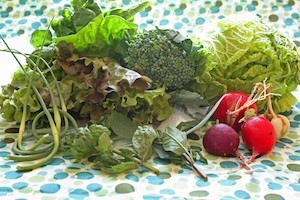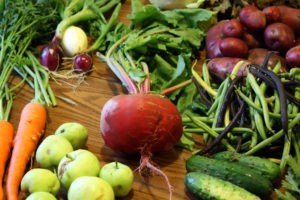 Last week was monumental in our house (er, yard): my raised garden beds got dug, built, filled, and (as of the writing of this post) one of the two of them got seeded. It’s glorious — the culmination of at least five months of planning, plotting, prepping, thinking, and researching.
Last week was monumental in our house (er, yard): my raised garden beds got dug, built, filled, and (as of the writing of this post) one of the two of them got seeded. It’s glorious — the culmination of at least five months of planning, plotting, prepping, thinking, and researching.
A few years ago when my brother and sister-in-law bought a hobby farm in southern Wisconsin, I thought they were daffy. Farming isn’t something people actively seek out, it’s something you’re born into doing, right? (And then probably leave?)
Well it turns out they were way ahead of me on this one. They’ve been, year by year and little by little, expanding their scope. They started with a small garden patch just a little bigger than my raised beds, a slew of chickens and ducks, and a couple of farm dogs; now they have at least half an acre of vegetable gardens, more chickens and ducks (and even turkeys sometimes), and a few sheep, mothering goats, pigs, cows, some mouse-catching cats, and animal herding dogs. They are supplying themselves with a significant portion of their own food, and they know where it came from and how it was grown or produced.
 Why does it matter what my brother’s family is doing in southern Wisconsin? Because it means that I have a direct source for information on how to get all of this “urban farming” stuff going, because they’ve been at it a few years.
Why does it matter what my brother’s family is doing in southern Wisconsin? Because it means that I have a direct source for information on how to get all of this “urban farming” stuff going, because they’ve been at it a few years.
And as someone interested in delicious food and sustainability, it felt like I was missing a piece of the puzzle by simply buying local and/or organic food (which I don’t even do as often as I’d like). Minnesota might be cold too many months out of the year to grow stuff like pineapples, but we can grow all sorts of yummies.
And, as my father-in-law keeps reminding me, nothing tastes as good as food straight out of the garden. So crisp, so fresh, and so full of flavor. I want in on that! I say yes to carrots and zucchini, raspberries and snap peas, and everything else. My brother and sister-in-law are also my inspiration — if they can do it, having grown up as city kids, so can I.
And so can you.
 My two raised beds are 4′ x 8′ each — the (rough) prescribed amount so you can reach all parts of the bed from one or two spots — reducing movement means easier and more efficient maintenance; from either of the long sides you can reach halfway into the bed and about two feet in either direction (for a span of four feet). The books recommend this layout because it takes less space without traditional farm rows (which are meant for tractors), and raising the beds gives your plants more vertical room to grow, which usually equates to higher yields (due to deeper root growth area) and less horizontal room needed — another reason you can plant more items in a smaller space.
My two raised beds are 4′ x 8′ each — the (rough) prescribed amount so you can reach all parts of the bed from one or two spots — reducing movement means easier and more efficient maintenance; from either of the long sides you can reach halfway into the bed and about two feet in either direction (for a span of four feet). The books recommend this layout because it takes less space without traditional farm rows (which are meant for tractors), and raising the beds gives your plants more vertical room to grow, which usually equates to higher yields (due to deeper root growth area) and less horizontal room needed — another reason you can plant more items in a smaller space.
I ordered the extra dirt required for filling in the beds, as well as manure and peat moss, from Gerten’s Greenhouse in Inver Grove Heights. For $60 (in addition to the cost of the materials) they delivered it to my driveway the next day. In hindsight, this was a super-smart move on my part. I cannot imagine getting all that soil (three cubic yards) into — and then OUT of — my mom’s Explorer, in addition to then moving it into the beds in the backyard.
Tip: If you’re thinking about starting your own garden, avoid the inclination to be (totally) overwhelmed.
In fact, every book and resource I’ve read say to take it easy your first year. If you lose interest because it gets too hard and intimidating, your garden will fail, most likely, if you even get started at all. In fact, two raised beds is probably too much garden for a first year, but I’ve been reminding myself that it’s ready for the future, and it’ll just have to be OK if it’s not perfectly tended this year, since I’m biting off more than the recommended amount.
Tip: Start small, and plant things you know that you and your household will eat.
 What am I growing?
What am I growing?
- Purple bush beans
- Green bush beans
- Snap peas
- Lettuce mix
- Romanesco broccoli
- Cauliflower
- Green cabbage
- Scarlet Nantes carrots
- Danvers carrots
- Pingtung long eggplant
- Red onions
- Yellow onions
 Leeks
Leeks- Melon (the picture looks like cantaloupe)
- Chervena Chushka pepper
- Fish peppers
- Habanero peppers
- Swiss chard
- Zucchini
- Potatoes
- Buttercup squash
- Carving pumpkins
- A few kinds of tomatoes (to be picked out at the Friends School Annual Plant Sale this weekend!)
- A mess of herbs, including Thai and Italian basil, tarragon, dill, lemon balm, chives, catnip (for my kitties), cilantro, and chamomile
- Raspberries
- Rhubarb
- And, last but not least, blueberries. Or maybe strawberries.
Whew! Many of them have been seeded since mid-March, living a (mostly) climate-controlled life under lamps while they await their new home in fresh soil with warm sunlight.The hot weather veggies and herbs (tomatoes, basil, etc.) will get their own planters at the front of the house where we get more direct sunlight.
My other tip? Share a garden with a friend (or three!).
It’s a great excuse to spend time together, seeding and transplanting, and later weeding and harvesting. You also then have someone to care for the garden if one of you is on vacation, as well as others to share the bounty with (God willing!).
Got some great urban farming/victory garden tips for others in the Twin Cities? Questions for me about my gardens? Ask away! Over the next few months I’ll try to fill you in on how my garden is going.




sara, this is FABULOUS! jason and i desperately want to follow suit! we started a way-too-big garden (not raised) a few years ago and maintenance and all sorts of creatures eating our food have been our two biggest obstacles. suggestions? tips? we *dream* of having the kids step out and gather the evening’s fruits and veggies. *sigh* what book do you recommend?
I feel like you guys could do well with container gardening. 1) you can move them wherever there is sun, 2) you can put them on wheeled bases for easy moving (if you deem necessary), and 3) they are scalable and manageable. Take inventory of your, say, 3-6 favorite vegetables and then hit the Friend’s School plant sale to pick up some seedlings — which mean you don’t have to start them from seed and you’ll only get as many as you need. Buy a bag or two of container-appropriate potting soil (a mix of fertilizer, peat moss, and soil), then stick those suckers in their new little homes. Don’t forget to water!
Next year, once you’re in the swing of things, expand your garden. Maybe set up a little patch to grow reliable veggies like carrots and radishes. You could even dig/set up part of it this fall and just not plant anything (you’d have to re-till/loosen the soil, but it would be less than doing everything for the first time next year).
As for books, I really like “The Vegetable Gardener’s Bible” by Edward C. Smith, which is heavy on photos and easily understandable info in 2-3 page bite-sized chunks. I was also just given “Dirt Cheap Green Thumb” by Rhonda Massingham Hart, and it’s solid — a handy guide, also with 2-4 page easily digestable chapters, but with more lists and illustrations.
Keep us posted on what you do!